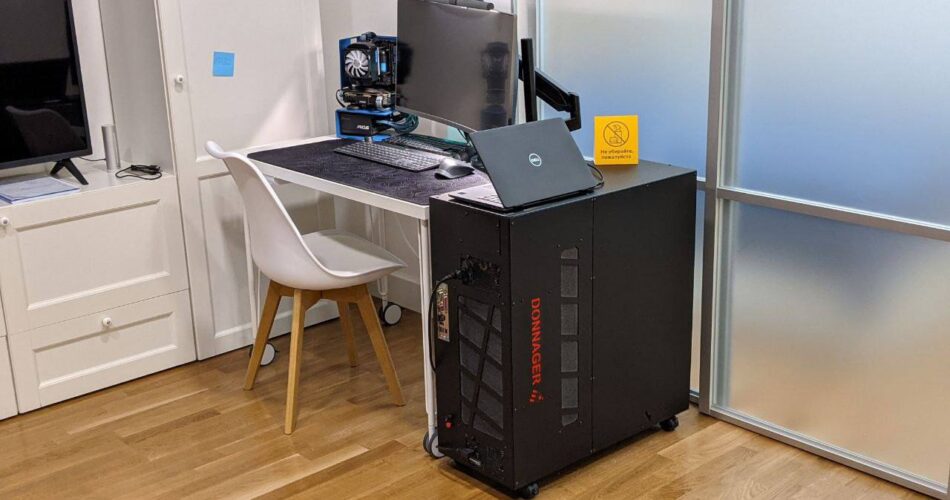Computer mining stands out as a revolutionary method of creating digital wealth. While often associated with cryptocurrency, computer mining’s scope extends beyond just digital coins. Let’s embark on a journey to understand this phenomenon and how it’s shaping the future of digital technology.
Table of Contents
What is Computer Mining?
Computer mining, at its core, is the process of using computer hardware to solve complex mathematical problems. This activity plays a pivotal role in various digital ecosystems, especially in the world of cryptocurrencies. But what exactly does it entail, and why is it so significant?
The Essence of Computer Mining
At a high level, computer mining involves dedicating computational resources to achieve a specific outcome. In the context of cryptocurrencies, this typically means validating and recording transactions on a digital ledger known as the blockchain.
The Mechanics of Computer Mining
Drawing insights from how crypto mining works, we’ll demystify the intricate processes behind computer mining, offering a clear understanding of its mechanics and significance.
The Role of Miners in Computer Mining
Miners are the backbone of the computer mining network. Their primary responsibilities include:
- Transaction Validation: Miners ensure the legitimacy of transactions, preventing issues like double-spending.
- Block Addition: After verifying transactions, they’re grouped into a block. Miners then append this block to the blockchain, a public ledger of all transactions.
Proof of Work (PoW) in Computer Mining
Most computer mining systems, similar to many cryptocurrencies, operate on a consensus mechanism called Proof of Work (PoW). Here’s a brief overview:
- Miners compete to solve intricate mathematical puzzles, demanding substantial computational power.
- The first miner to crack the puzzle earns the privilege to add a new block to the blockchain.
- Other miners then validate the solution. If the majority concurs, the block joins the chain.
Mining Difficulty and Its Impact
To ensure a consistent rate of block addition, the network tweaks the puzzle’s difficulty:
- If blocks are added too swiftly, the puzzle becomes more challenging.
- Conversely, if blocks are added too slowly, the difficulty is reduced. This self-regulating mechanism guarantees the network’s stability and security.
Rewards and Incentives in Computer Mining
Miners are incentivized in two primary ways:
- Block Rewards: For every block added, miners receive a predetermined number of rewards. This reward undergoes periodic halving.
- Transaction Fees: Users can attach fees to their transactions to motivate miners to prioritize and validate them. These fees offer an additional reward for miners.
Evolution of Computer Mining
Mining has witnessed significant evolution over the years:
- Solo Mining: Initially, individual miners utilized personal computers for mining tasks.
- Pool Mining: As the difficulty escalated, miners began pooling resources to enhance their chances of obtaining rewards.
- Rental Mining: Nowadays, individuals can rent mining power from computer mining companies, eliminating the need for personal hardware.
Types of Computer Mining
The type of hardware used plays a pivotal role in determining efficiency, profitability, and overall success. While there are various methods and devices available for mining, when it comes to computer mining rig, three primary types stand out: CPU, GPU, and FPGA mining. Let’s delve deeper into these types to understand their intricacies, advantages, and challenges.
CPU Mining
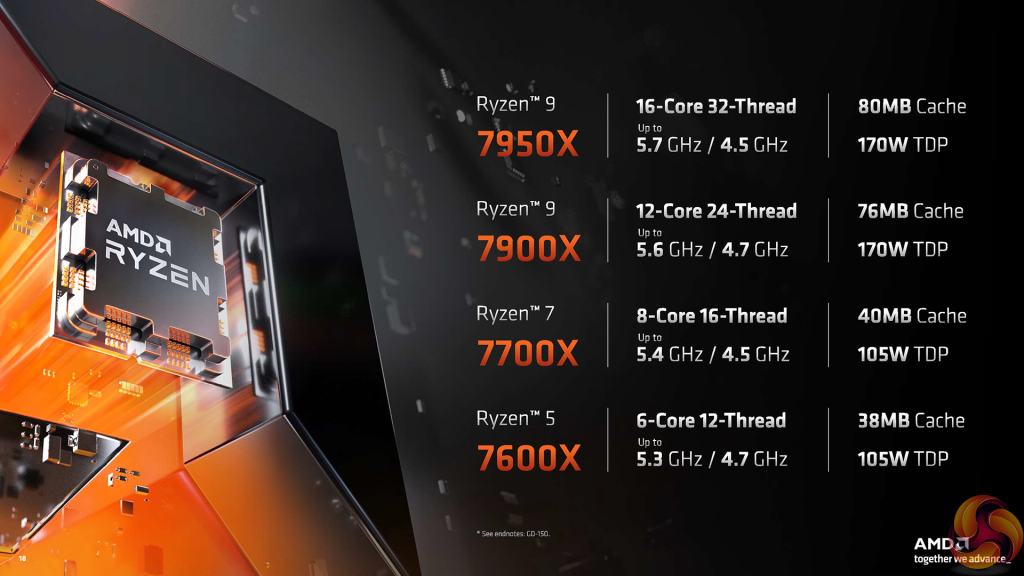
CPU (Central Processing Unit) mining is the original form of computer mining. It involves using the main processor of the computer mining rig to perform the mining operations.
Prominent CPU manufacturers include Intel (with their Core and Xeon series) and AMD (with their Ryzen and EPYC series).
Installation Guidelines:
- Ensure the CPU socket matches the mining motherboard‘s socket (e.g., LGA1151, AM4).
- Apply thermal paste on the CPU before placing the cooler.
- Secure the CPU cooler, ensuring it has proper contact with the CPU for efficient heat dissipation.
Pros:
- Accessibility: Almost every computer has a CPU, making it easily accessible for beginners.
- Versatility: Suitable for mining algorithms that don’t require intense computational power.
Cons:
- Limited Power: CPUs are designed for general tasks and lack the specialized architecture for efficient mining.
- Higher Energy Consumption: Compared to the rewards, CPU mining can be less energy-efficient.
GPU Mining
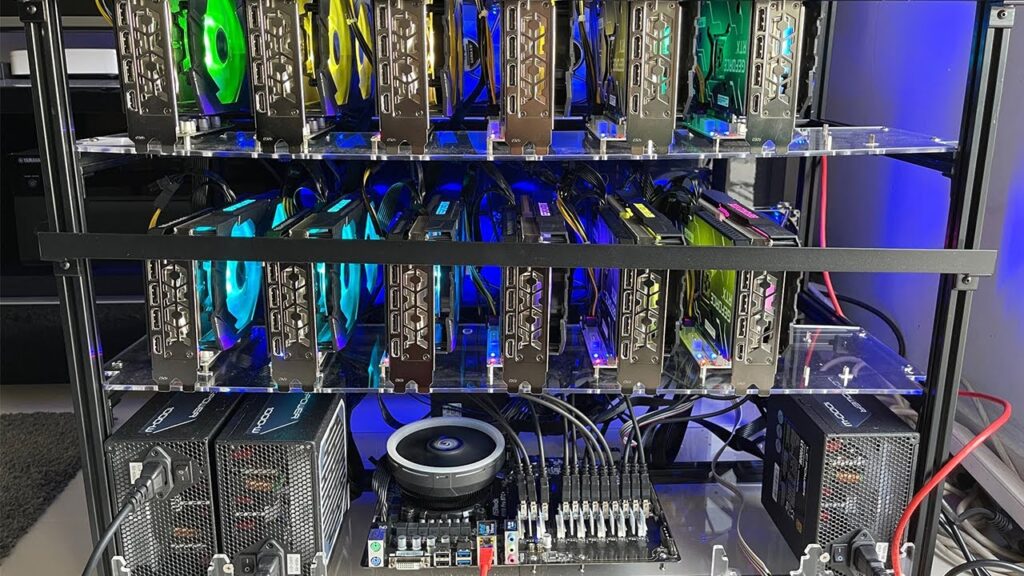
GPU (Graphics Processing Unit) mining utilizes the graphics card of a computer, typically used for rendering video and graphics, for mining purposes. Due to their parallel processing capabilities, GPUs can handle more calculations simultaneously.
Leading GPU manufacturers include NVIDIA (with their GTX and RTX series) and AMD (with their Radeon series).
Installation Guidelines:
- Ensure your motherboard has an available PCI Express (PCIe) slot.
- Connect the GPU to the PCIe slot and secure it.
- Connect necessary power cables from the power supply unit to the GPU.
Pros:
- Enhanced Performance: GPUs can process multiple algorithms simultaneously, making them significantly faster than CPUs.
- Flexibility: Suitable for a variety of cryptocurrencies and algorithms.
- Resale Value: Even after their mining utility diminishes, GPUs retain value for gaming and other graphic-intensive tasks.
Cons:
- Initial Investment: A robust GPU setup can be costly.
- Heat Production: GPUs can generate a lot of heat, necessitating effective cooling solutions.
FPGA Mining
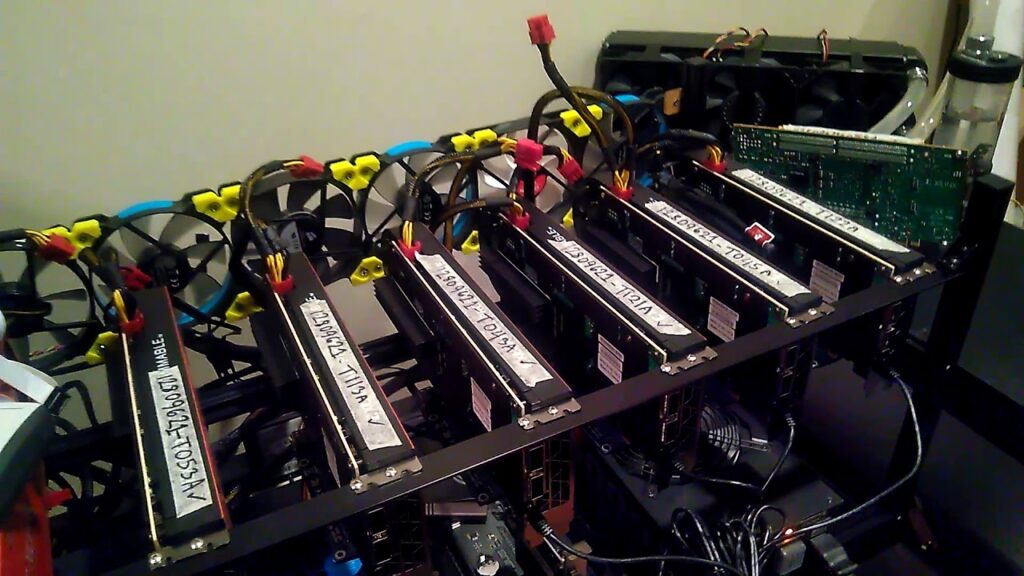
FPGA (Field-Programmable Gate Array) mining involves using integrated circuits that can be reprogrammed post-manufacturing to execute specific tasks. They offer a middle ground between GPUs and more specialized ASICs (which we aren’t delving into here).
Key FPGA manufacturers include Xilinx (with their Virtex and Kintex series) and Altera (now Intel).
Installation Guidelines:
- Ensure your motherboard has an available PCIe slot.
- Insert the FPGA board into the PCIe slot and secure it.
- Depending on the FPGA board, additional power connections might be required.
Pros:
- Customization: FPGAs can be tailored to specific algorithms, enhancing their efficiency.
- Energy Efficiency: They offer better performance-per-watt compared to GPUs and CPUs.
Cons:
- Complexity: Setting up and programming FPGAs can be more complex than using ready-to-mine GPUs or CPUs.
- Cost: While they can be more affordable than high-end ASICs, FPGAs can still be pricier than GPUs, especially when considering development tools and time.
Best Computer for Mining Crypto
The experts at WoolyPooly’s mining team have crafted a specification that stands out in terms of performance, versatility, and value for money. Let’s delve into their recommended setup, which not only promises excellent mining capabilities but also versatility across most algorithms.
1. CPU: AMD Ryzen 9 3950X
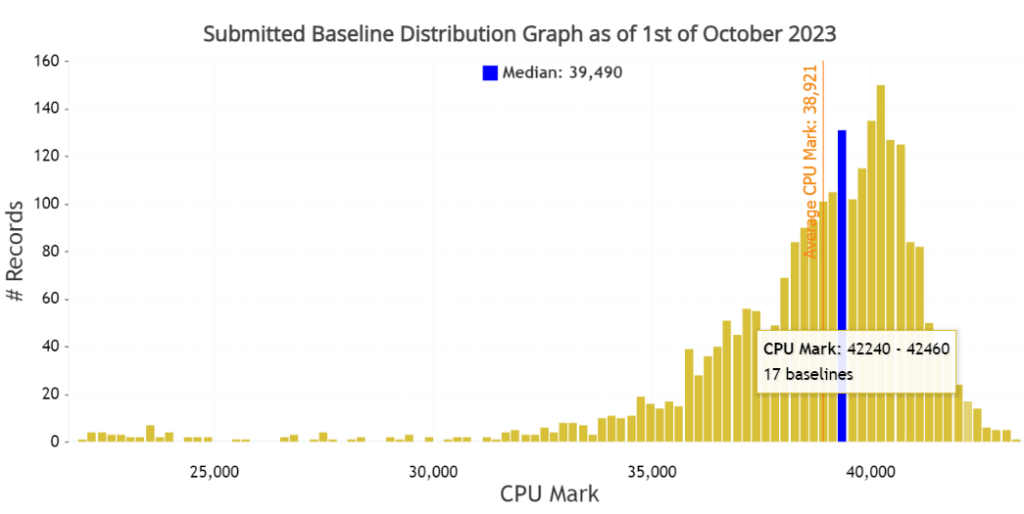
The heart of any computer, the CPU plays a crucial role in mining, especially for algorithms that are CPU-intensive. The AMD Ryzen 9 3950X, with its multiple cores and threads, offers a perfect blend of power and efficiency.
- Benefits:
- High Performance: With multiple cores, it can handle parallel tasks efficiently, making it ideal for multitasking and mining operations.
- Energy Efficiency: AMD’s architecture ensures that the CPU doesn’t consume excessive power, ensuring a balance between performance and energy consumption.
2. Motherboard: MSI B450-A PRO MAX
A motherboard acts as the foundation, connecting all components. The MSI B450-A PRO MAX is known for its stability, compatibility, and robust build.
- Benefits:
- Multiple GPU Support: This motherboard can comfortably support multiple GPUs, making it ideal for a mining rig setup.
- Durability: Built with high-quality components, it ensures longevity and stable performance.
3. GPU: Nvidia RTX 3080ti (7 pcs)
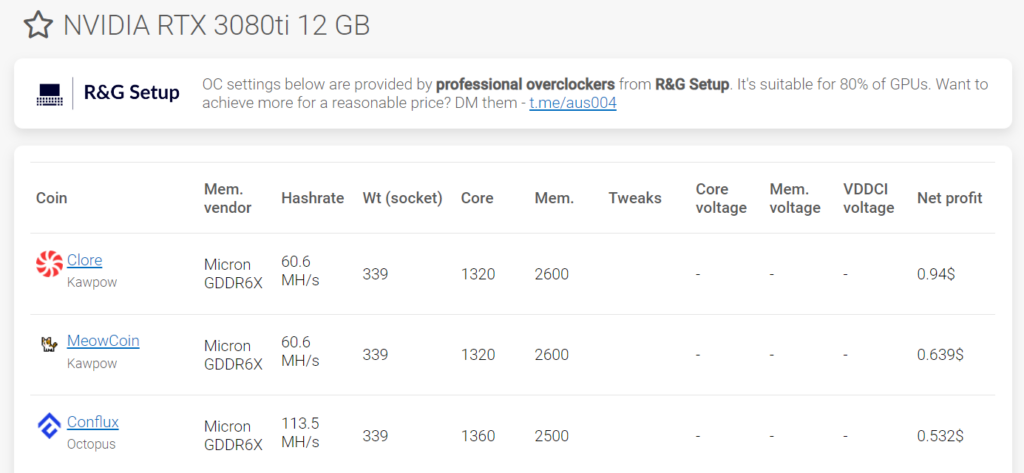
The GPU is the workhorse of any mining operation, especially for algorithms that are GPU-intensive. The Nvidia RTX 3080ti is a powerhouse, designed for high-performance tasks like gaming and, of course, mining.
- Benefits:
- Outstanding Performance: With 7 of these GPUs, the mining power is exponentially increased, ensuring maximum profitability.
- Versatility: The RTX 3080ti is not just limited to one or two algorithms. Its architecture ensures it can handle a variety of mining algorithms with ease.
- Efficient Cooling: The design ensures that the GPU remains cool even under intense mining operations, prolonging its lifespan.
Versatility and Value
One of the standout features of this setup is its versatility. Whether you’re mining EthereumPOW, Ravencoin, new CPU coin or any other cryptocurrency, this rig is designed to handle most algorithms with ease. Furthermore, for those looking for value, purchasing this setup used can offer significant cost savings without compromising on performance. The WoolyPooly mining team’s recommendation ensures that miners get a system that’s not just powerful but also offers excellent value for money.
Computer Mining Software
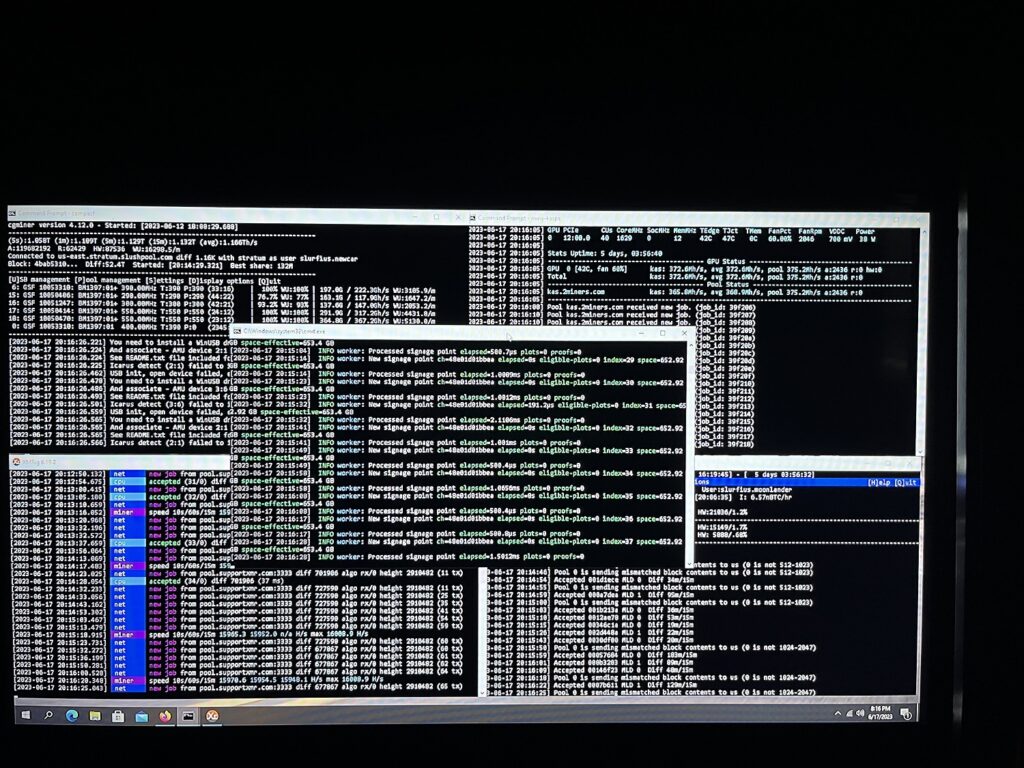
Mining digital assets requires not just the right hardware but also the right software to drive these machines efficiently. The mining software acts as the bridge between the hardware and the mining pool or blockchain. It fetches work, processes it, and then submits the solutions back. Let’s delve into some of the top mining software options.
| Mining Software | Description | Compatibility | Coins Supported |
|---|---|---|---|
| Teamredminer | Popular for its efficiency with AMD graphics cards. | AMD GPUs, FPGA | ETHW, ETC, RVN, Clore, ERG |
| Trex | Versatile miner optimized for Nvidia GPUs. Supports multiple algorithms. | Nvidia GPUs | ETHW, ETC, RVN, Clore, ERG, CFX |
| Lolminer | Supports a range of algorithms. Compatible with both AMD and Nvidia GPUs. | AMD & Nvidia GPUs | ETHW, ETC, RVN, Clore, ERG, CFX, Nexa |
| Bzminer | Newer software known for efficiency and support for multiple algorithms. | AMD & Nvidia GPUs | ETHW, ETC, RVN, Clore, ERG, CFX, Nexa, RXD |
| Xmrig | Best CPU miner supporting both Interl and AMD processors. | Intel & AMD CPUs | RTM, XMR |
The Profitability Quotient
The Profitability Quotient is a measure used to determine the potential profitability of mining a particular cryptocurrency. It takes into account various factors, including:
- Hash Rate: This is the speed at which a computer can complete an operation in the cryptocurrency code. A higher hash rate means a more powerful mining capability.
- Power Consumption: Mining requires computational power, which in turn consumes electricity. The cost of electricity can significantly impact profitability.
- Current Price of the Cryptocurrency: The market price of the cryptocurrency being mined is a direct factor in determining its profitability.
- Mining Difficulty: This refers to how hard it is to earn a reward from mining. As more miners join the network, the difficulty typically increases, reducing the potential rewards for individual miners.
- Block Rewards: This is the number of coins or tokens awarded to miners for every block they successfully mine.
Given these factors, the Profitability Quotient can be seen as a dynamic value that changes based on market conditions, technological advancements, and other external factors.
Role of Mining Calculators
Mining calculators, like “WhatToMine” and “WoolyPooly”, are tools designed to help miners estimate their potential earnings based on the current conditions of the cryptocurrency market. Here’s a brief overview of each:
1. WhatToMine:
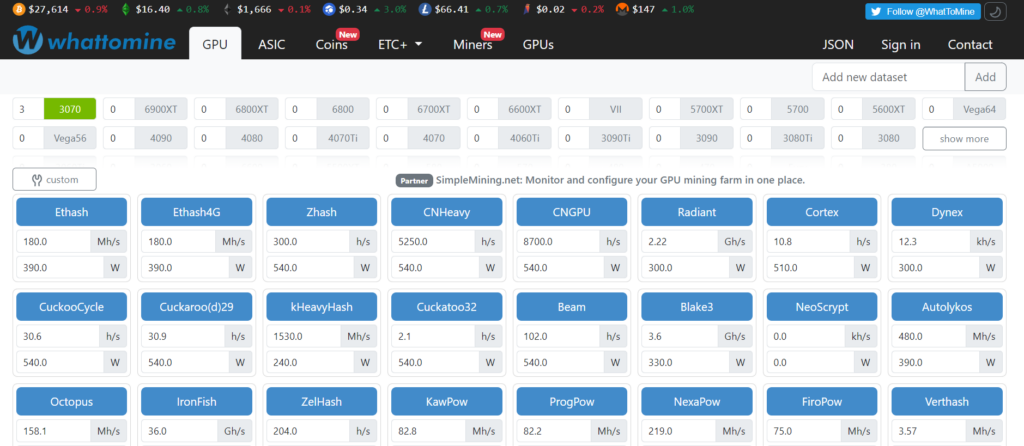
- Provides a comprehensive list of cryptocurrencies, their current prices, block rewards, and hash rates.
- Allows users to input their hardware specifications and electricity costs to get a tailored profitability estimate.
- Offers a comparison between different cryptocurrencies to help miners decide which one is the most profitable to mine at any given time.
2. WoolyPooly:
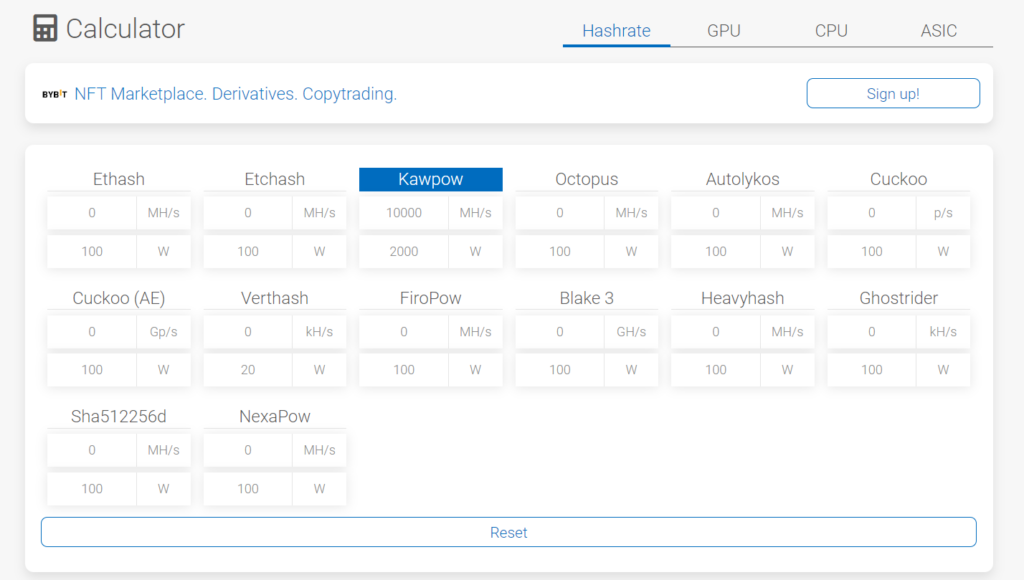
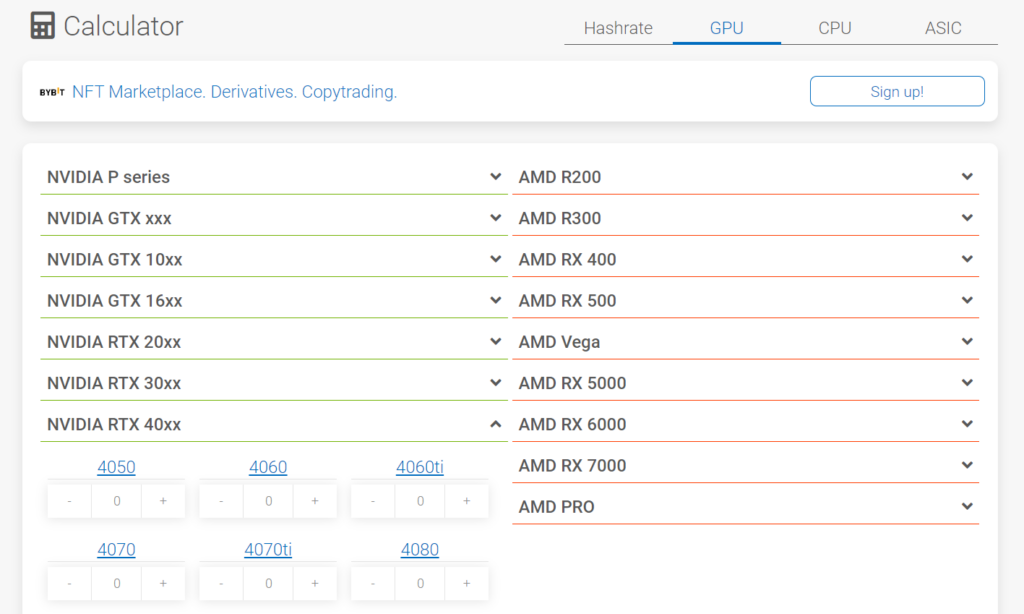
- Offers a crypto mining profitability calculator where users can input their hash rate for various algorithms to get profit estimates in different currencies.
- Helps users determine their hash rate based on their specific mining equipment, be it a GPU, CPU, or ASIC.
- Provides insights into various cryptocurrencies, their rewards, prices, and other relevant metrics.
In essence, these tools simplify the process of determining the Profitability Quotient for miners. By inputting specific parameters, miners can get a clearer picture of their potential earnings and make informed decisions on which cryptocurrency to mine.
Risks and Challenges in Computer Mining
Computer mining, while lucrative and intriguing, is not without its challenges. As the digital landscape evolves, miners face a plethora of risks, from hardware limitations to market volatility. Understanding these challenges is crucial for anyone venturing into the mining domain. Let’s delve into the various risks and challenges associated with computer mining.
1. Hardware Wear and Tear
Continuous high temperature (under 70 degrees) mining operations can strain computer components, leading to faster degradation.
- Impact: Reduced lifespan of components like CPUs, GPUs, and cooling systems.
- Mitigation: Regular maintenance, ensuring adequate cooling, and not pushing components beyond their limits can help prolong hardware life.
2. High Electricity Costs
Mining operations, especially those using GPUs, can consume significant amounts of electricity.
- Impact: Increased operational costs which can offset potential mining profits.
- Mitigation: Using energy-efficient components, optimizing mining software settings, and considering renewable energy sources can help manage electricity costs.
3. Market Volatility
The value of cryptocurrencies can be highly volatile, with prices fluctuating dramatically in short periods.
- Impact: The profitability of mining can vary day-to-day, making it challenging to predict long-term returns.
- Mitigation: Diversifying mining operations across various cryptocurrencies and staying updated on market trends can help navigate volatility.
4. Regulatory and Legal Challenges
Cryptocurrencies and mining operations face regulatory scrutiny in various countries.
- Impact: Potential legal challenges, restrictions, or even bans on mining activities in certain jurisdictions.
- Mitigation: Staying informed about local regulations, engaging in community discussions, and considering legal counsel can help miners stay compliant.
5. Security Threats
Mining operations can be targeted by hackers, leading to theft of rewards or compromising mining rigs.
- Impact: Loss of mined assets, potential damage to hardware, and loss of trust in the mining community.
- Mitigation: Employing robust security measures, using trusted mining software, and regularly updating and patching systems can enhance security.
6. Increased Competition
As more individuals and entities enter the mining space, the competition for block rewards intensifies.
- Impact: Reduced chances of solving blocks and earning rewards, especially for solo miners.
- Mitigation: Joining mining pools, staying updated with technological advancements, and optimizing operations can help stay competitive.
7. Technological Obsolescence
The rapid evolution of mining hardware and software can render existing setups obsolete.
- Impact: Reduced mining efficiency and profitability over time as newer, more efficient solutions emerge.
- Mitigation: Regularly reviewing and updating hardware and software, and staying informed about industry advancements can help mitigate obsolescence.
The Future of Computer Mining
Computer mining has witnessed a meteoric rise in the past decade, evolving from a niche hobby to a global industry. As we stand on the cusp of technological advancements and shifting economic landscapes, it’s imperative to ponder the future trajectory of computer mining. Let’s explore some key trends and developments that could shape the next chapter of this digital endeavor.
1. Sustainability and Green Mining
Environmental concerns are increasingly coming to the forefront, with the carbon footprint of mining operations under scrutiny. Traditional mining setups, especially those relying on non-renewable energy sources, have been criticized for their environmental impact.
In response, the industry is gravitating towards more sustainable solutions. We’re witnessing a surge in mining farms powered by renewable energy sources like solar, wind, and hydroelectric power. The emphasis is on creating a balance between profitability and ecological responsibility. As global focus sharpens on sustainability, green mining could become the norm rather than the exception.
2. Technological Advancements in Hardware
The relentless pace of technological innovation ensures that the mining hardware of today might become obsolete tomorrow. We’re on the brink of witnessing more energy-efficient and powerful CPUs, GPUs, and even FPGAs. These advancements promise to enhance the mining efficiency, reduce energy consumption, and potentially democratize access to mining by making it more affordable.
Moreover, as quantum computing inches closer to practical application, its potential impact on computer mining could be revolutionary. While it might pose challenges to current cryptographic standards, it could also usher in a new era of ultra-efficient mining.
3. Regulatory Landscape and Decentralization
The regulatory environment for cryptocurrencies and computer mining remains fluid, with countries oscillating between acceptance, regulation, and outright bans. This dynamic poses challenges but also opportunities. As some countries clamp down on mining activities, others are opening their doors, offering incentives and creating mining-friendly ecosystems.
Furthermore, the ethos of decentralization that underpins cryptocurrencies is also influencing computer mining. There’s a growing emphasis on creating decentralized mining pools and platforms, reducing the control of major players and distributing rewards more equitably among participants.
4. Evolution of Mining Algorithms and Proof Systems
The traditional Proof of Work (PoW) consensus mechanism, while foundational to many cryptocurrencies, is resource-intensive. In light of environmental concerns and efficiency pursuits, alternative consensus mechanisms like Proof of Stake (PoS) and hybrid models are gaining traction.
Ethereum’s transition to PoS was a testament to this shift. Check our proof of work vs proof of stake guide to know more about this battle. As these alternative mechanisms become more prevalent, the role and nature of computer mining could undergo significant transformation. Miners might transition from validators of transactions to validators of stakes or even play roles in hybrid systems that combine the best of both worlds.
Conclusion
Computer mining is as intricate as it is fascinating. From understanding the foundational principles of what computer mining entails to grasping the nuances of profitability, risks, and future prospects, it’s evident that this digital endeavor is multifaceted.
As we’ve journeyed through the various aspects of computer mining, several key takeaways emerge:
- Adaptability is Crucial: The mining landscape is in constant flux, influenced by technological advancements, market dynamics, and regulatory shifts. Miners must remain adaptable, ready to pivot their strategies based on emerging trends and challenges.
- Tools are Invaluable: Platforms like “WhatToMine” and “WoolyPooly” underscore the importance of leveraging tools to make informed decisions. These calculators and platforms simplify complex data, offering miners insights that can significantly impact profitability.
- Sustainability is the Future: As global consciousness shifts towards environmental sustainability, the mining industry will inevitably need to adapt. Green mining initiatives and energy-efficient technologies will play a pivotal role in shaping the future of computer mining.
- Knowledge is Power: Whether it’s understanding the mechanics of mining, the risks involved, or the potential rewards, knowledge remains a miner’s most potent weapon. Staying informed and continuously learning will be paramount for success in this domain.
In essence, computer mining is a testament to human ingenuity, blending technology, economics, and cryptography to create a unique digital ecosystem. As we look to the future, one thing is certain: computer mining will continue to evolve, presenting both challenges and opportunities. For those willing to navigate its complexities, the rewards—both tangible and intangible—can be profound.
FAQs
Is computer mining limited to cryptocurrency?
No, computer mining has a broader scope, including data validation, complex problem solving, and more.
How can I start with computer mining?
Begin with understanding the type of mining you’re interested in, invest in the necessary hardware and software, and continuously educate yourself about the latest trends.
Is computer mining environmentally harmful?
Traditional mining methods can be energy-intensive, but there’s a growing shift towards sustainable and eco-friendly mining practices.
Is my old computer mining Bitcoin?
Yes, technically, it’s possible to mine Bitcoin with an old computer. However, you wouldn’t earn any rewards because Bitcoin mining is now dominated by ASICs (Application-Specific Integrated Circuits), making personal computer mining non-competitive.
